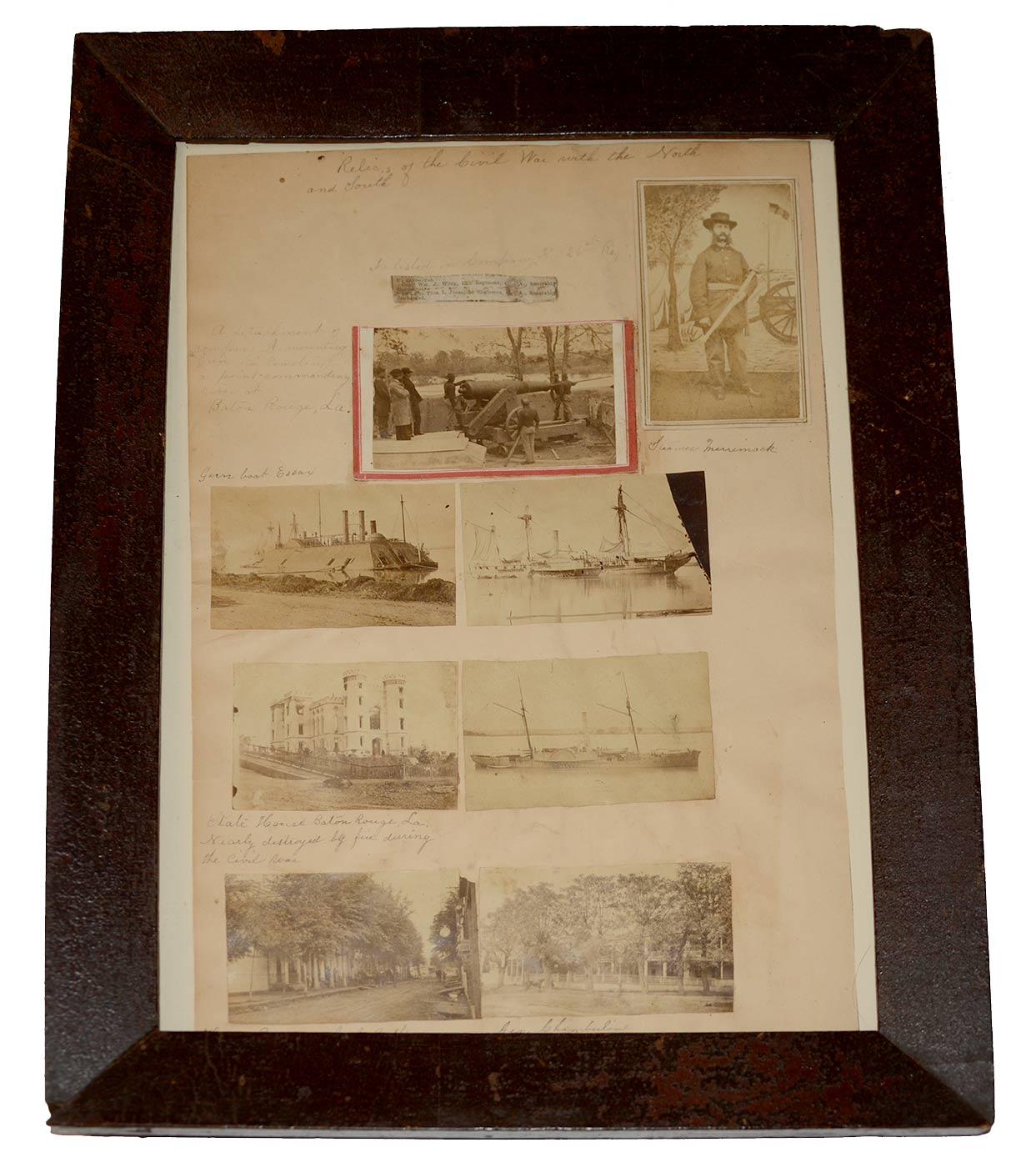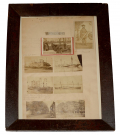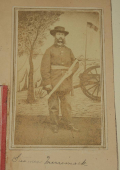site search
online catalog
FRAMED SCRAPBOOK PAGE WITH 8 CDV SIZED IMAGES FROM 26TH MASSACHUSETTS & LATER COLORED TROOPS OFFICER WILLIAM J. WILEY

$1,295.00
Quantity Available: 1
Item Code: 915-17
Manila scrapbook page meas. approx. 12.50 x 16.50 inches framed and adorned with eight CDV sized images relating to the service of William J. Wiley of the 26th Massachusetts and later the 75th & 84th U.S. Colored Troops.
Wiley was born I Thomaston, Massachusetts and at age 27 enlisted as a private in Company H, 26th Massachusetts at Boston on September 2, 1861 and was promoted to corporal the following November 1st.
The 26th was sent to New Orleans as part of General Benjamin Butler’s New Orleans expedition. After the city fell the regiment did occupation and guard duty there.
On January 23, 1863 Wiley was detached from his Company and sent to Baton Rouge to act as a drill master and in February he was discharged to accept a commission as 1st lieutenant in Company H, 75th US Colored Infantry with date of rank from March 4, 1863.
While with the 75th Wiley was present during the siege of Port Hudson where through May and June his regiment suffered the loss of three killed and one wounded. The records for July and August of 1863 find Lieutenant Wiley under arrest for being absent without leave. What became of the charges is not known.
In September of 1863 Companies H, I, and K of the 75th were transferred to the 84th US Colored Troops. Wiley was assigned to command Company E of the 84th on October 10, 1863 and was promoted to captain on October 27. However, Wiley’s health began to fail and he resigned on February 16, 1864.
Somewhat regaining his health by August of 1864, Wiley enlisted again as a private and unassigned recruit in the 33rd Massachusetts Infantry. He was kept at the Draft Camp in Boston Harbor until discharged on December 16, 1864 to be commissioned again in the US Colored Troops but nothing ever came of it.
Nothing is known of his post-war life.
Turning our attention to the album page it bears a period ink inscription at the top that reads “RELICS OF THE CIVILL WAR WITH THE NORTH AND SOUTH.”
The first CDV is a full standing view of Wiley posed in front of a painted backdrop depicting a camp scene with cannon. He is cradling a saber in his left arm. He wears a dark slouch hat with regimental numbers on the front of the crown. Unfortunately, the numbers are too small to discern. He also wears a dark commercial four button sack coat with sash and light-colored trousers. Contrast and clarity are good as are the paper and mount.
Next is a period ink inscription “INLISTED IN COMPANY K 26th REG.” and below this is a newspaper clipping announcing Wiley’s discharge from the 84th USCT.
The next item is a CDV of a large caliber Columbiad gun on a barbette carriage. The image shows the gun in a fort with two men working the rammer at the muzzle and one man plugging the vent while three officers look on. The period ink caption with the image reads “A DETACHMENT OF COMPANY A MOUNTING GUN IN CEMETERY A POINT COMMANDING RIVER AT BATON ROUGE, LA.” Contrast and clarity are excellent. Mount has red border that has been slightly trimmed along the top edge.
Just below this is a CDV sized image labeled in period ink as “GUNBOAT ESSEX.” She is seen from the stern and looking along her port side. The “ESSEX” was formally transferred to the Navy in October 1862 and remained active on the rivers through the rest of the Civil War. She bombarded Port Hudson, Louisiana, and helped with the occupation of Baton Rouge in December 1862. In May-July 1863 she participated in the capture of Port Hudson. She took part in the Red River expedition in March-May 1864. “ESSEX” was decommissioned in July 1865. After her sale to private interests in November of that year, she reverted to the name “NEW ERA”. She was scrapped in 1870. Image has excellent clarity and contrast and is unmounted.
Beside the above image is a view labeled as “STEAMER MERRIMACK.” The ship is a sidewheeler and the image is a view of her starboard side. Image has good contrast and clarity and is unmounted.
The next image in the collection is of a large building with a double turreted front with a wrought iron fence around it. The image is labeled “STATE HOUSE BATON ROUGE, LA. NEARLY DESTROYED BY FIRE DURING THE CIVIL WAR.” Contrast and clarity are good and the image is unmounted. The building still stands today and can be visited.
Next is a photo of the USS MISSISSIPPI. She is seen at anchor and the image is a few of the starboard side. Contrast and clarity are very good and the image is unmounted. The USS MISSISSIPPI was a paddle frigate and was the first ship of the United States Navy to bear that name. She was named for the Mississippi River. Her keel was laid down by the Philadelphia Navy Yard in 1839; built under the personal supervision of Commodore Matthew Perry. She was commissioned on 22 December 1841, with Captain W. D. Salter in command and launched several weeks later. During the Mexican War, she took part in expeditions against Alvarado, Tampico, Pánuco, and Laguna de Términos and Veracruz, as well as a series of coastal raids on Mexico's east coast, taking part in the capture of Tabasco in June 1847. After the war with Mexico she sailed with Admiral Perry to Japan in the late 1850’s. During the Civil War she did blockade duty and took part in Admiral Farragut’s fight with Forts Jackson and St. Philip and the capture of New Orleans. During the fighting on April 24, 1862 the USS MISSISSIPPI ran the Confederate ram MANASSAS ashore wrecking her with two mighty broadsides. It was during this fight that one of her sailors was awarded the Medal of Honor. The ship remained off New Orleans for the next year during which time this photo was probably taken. The MISSISSIPPI was then ordered upriver for the operations against Port Hudson, Louisiana. On 14 March 1863, she grounded while attempting to pass the forts guarding Port Hudson. Under enemy fire, every effort was made to refloat her by Captain Melancton Smith and his executive officer George Dewey (later to achieve fame as an admiral). At last, her machinery was destroyed, her battery spiked, and she was fired to prevent Confederate capture. When the flames reached her magazines, she blew up and sank. Three of Mississippi's men, Seaman Andrew Brinn, Boatswain's Mate Peter Howard, and U.S. Marine Corps Sergeant Pinkerton R. Vaughn, were awarded the Medal of Honor for their actions during the abandonment. She lost 64 men, with the accompanying ships saving 223 of her crew.
The last two images in the group show headquarters buildings. The first shows a tree lined street with buildings on both sides. This is labeled “HEAD QUARTERS GEN BUTLER NEW ORLEANS LA.” The trees along the street have grown so close together it is difficult to see the buildings. Contrast and clarity are very good but image is unmounted. The last image shows a large building taking up one side of a tree lined street. The image is labeled simply “GEN. CHAMBERLINE” The image has excellent clarity and contrast but is also unmounted.
The dark wood frame looks to be the original however a new foam core backing has been put in place. [ad] [ph:L]
Extra shipping charge may be required.
~~~~~~~~~~~~~~~~~~~~~~~~~~~~~~~~~~~
THIS ITEM, AS WITH ALL OTHER ITEMS AVAILABLE ON OUR WEB SITE,
MAY BE PURCHASED THROUGH OUR LAYAWAY PROGRAM.
CLICK HERE FOR OUR POLICIES AND TERMS.
THANK YOU!
Inquire About FRAMED SCRAPBOOK PAGE WITH 8 CDV SIZED IMAGES FROM 26TH MASSACHUSETTS & LATER COLORED TROOPS OFFICER WILLIAM J. WILEY
For inquiries, please email us at [email protected]
Most Popular
Historical Firearms Stolen From The National Civil War Museum In Harrisburg, Pa »
Theft From Gravesite Of Gen. John Reynolds »
Selection Of Unframed Prints By Don Troiani »
Fine Condition Brass Infantry Bugle Insignia »
British Imported, Confederate Used Bayonet »
Scarce New Model 1865 Sharps Still In Percussion Near Factory New »
featured item
ID’D P1855 MOUNTED SERVICES MUSICIAN’S SHELL JACKET – WILLIAM OSWALD, 4th PENNSYLVANIA CAVALRY
William Oswald resided in Northampton County, Pennsylvania when he enlisted on August 15th, 1861. On that same day, he mustered into Company “A” of the 4th Pennsylvania Cavalry as a Bugler. Initially, the regiment was organized at Pittsburgh,… (1268-776). Learn More »
site search
Upcoming Events
May 16 - 18: N-SSA Spring Nationals, Fort Shenandoah, Winchester, VA Learn More »








